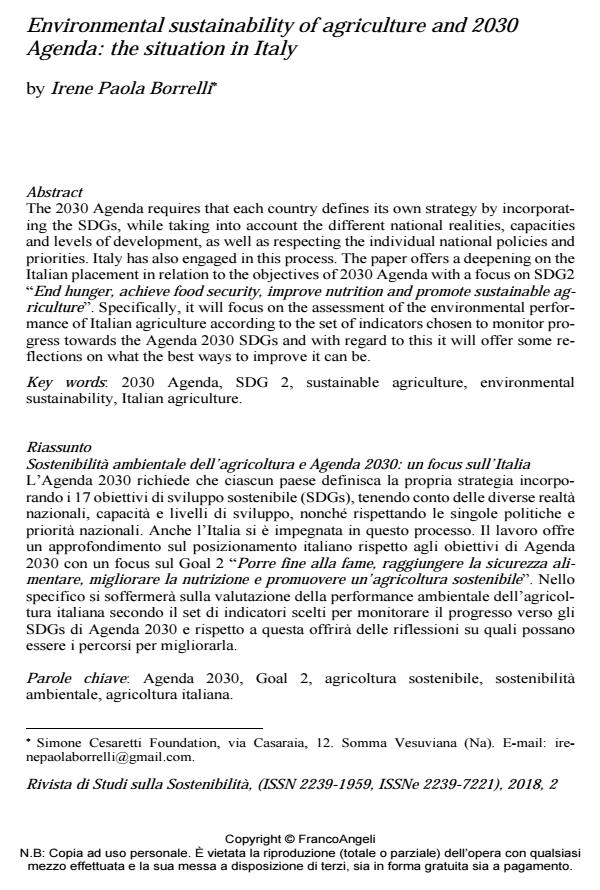Environmental sustainability of agriculture and 2030 Agenda: the situation in Italy
Titolo Rivista RIVISTA DI STUDI SULLA SOSTENIBILITA'
Autori/Curatori Irene Paola Borrelli
Anno di pubblicazione 2019 Fascicolo 2018/2
Lingua Inglese Numero pagine 19 P. 85-103 Dimensione file 295 KB
DOI 10.3280/RISS2018-002006
Il DOI è il codice a barre della proprietà intellettuale: per saperne di più
clicca qui
Qui sotto puoi vedere in anteprima la prima pagina di questo articolo.
Se questo articolo ti interessa, lo puoi acquistare (e scaricare in formato pdf) seguendo le facili indicazioni per acquistare il download credit. Acquista Download Credits per scaricare questo Articolo in formato PDF

FrancoAngeli è membro della Publishers International Linking Association, Inc (PILA)associazione indipendente e non profit per facilitare (attraverso i servizi tecnologici implementati da CrossRef.org) l’accesso degli studiosi ai contenuti digitali nelle pubblicazioni professionali e scientifiche
The 2030 Agenda requires that each country defines its own strategy by incorporating the SDGs, while taking into account the different national realities, capacities and levels of development, as well as respecting the individual national policies and priorities. Italy has also engaged in this process. The paper offers a deepening on the Italian placement in relation to the objectives of 2030 Agenda with a focus on SDG2 "End hunger, achieve food security, improve nutrition and promote sustainable agriculture". Specifically, it will focus on the assessment of the environmental performance of Italian agriculture according to the set of indicators chosen to monitor progress towards the Agenda 2030 SDGs and with regard to this it will offer some reflections on what the best ways to improve it can be.
L’Agenda 2030 richiede che ciascun paese definisca la propria strategia incorpo-rando i 17 obiettivi di sviluppo sostenibile (SDGs), tenendo conto delle diverse realtà nazionali, capacità e livelli di sviluppo, nonché rispettando le singole politi-che e priorità nazionali. Anche l’Italia si è impegnata in questo processo. Il lavoro offre un approfondimento sul posizionamento italiano rispetto agli obiettivi di Agenda 2030 con un focus sul Goal 2 "Porre fine alla fame, raggiungere la sicu-rezza alimentare, migliorare la nutrizione e promuovere un’agricoltura sostenibi-le". Nello specifico si soffermerà sulla valutazione della performance ambientale dell’agricoltura italiana secondo il set di indicatori scelti per monitorare il progresso verso gli SDGs di Agenda 2030 e rispetto a questa offrirà delle riflessioni su quali possano essere i percorsi per migliorarla.
Parole chiave:Agenda 2030, Goal 2, agricoltura sostenibile, sostenibilità ambientale, agricoltura italiana.
- ASviS (2017), L’Italia e gli Obiettivi di Sviluppo Sostenibile – Rapporto 2017 -- http://asvis.it/public/asvis/files/ASviS_REPORT_2017.pdf.
- ASviS (2018), L’Italia e gli Obiettivi di Sviluppo Sostenibile – Rapporto 2018 -- http://asvis.it/public/asvis/files/ASviS_REPORT_2018_Ristampa.pdf.
- Campiotti C.A., Morosinotto G., Puglisi G., Schettini E., Vox G. (2016). Performance evaluation of a solar cooling plant applied for greenhouse thermal control. Agriculture and agricultural science procedia, 8: 664-669.
- Cesaretti G.P., Viola I., Misso R., Borrelli I.P. (2013). Green society-a conceptual framework of sustainability from a territorial perspective. Calitatea, 14(3), 50.
- CREA (2017). Italian Agriculture Yearbook, vol. LXIX., Roma.
- Di Bonito R., Biagiotti D., Giagnacovo G., Canditelli M., Campiotti C.A. (2015, April). Use of compost as amendment for soilless substrates of plants in green roof installations. In III International Symposium on Organic Matter Management and Compost Use in Horticulture 1146 (pp. 143-148).
- European Commission (2014). Best environmental management practice for the agriculture sector – crop and animal production, Bruxelles.
- European Commission (2016). EIP-AGRI Focus Group Water & agriculture: adaptive strategies at farm level, Final Report.
- Eurostat (2018). Sustainable Development in the European Union. Overview of Progress Towards the SDGs in an EU Context. Luxembourg: Publications Office of the European Union.
- Fabbri C., Soldano M., Piccinini S. (2011). Biogas accelerates the race towards the 2020 targets. Informatore Agrario Supplemento, 67(26 Supplemento): 15-19.
- FAO (FOOD AND AGRICULTURE ORGANISATION). FAO Statistical Database. Rome, (-- Available at http://faostat.fao.org/default.aspx) 2012.
- Guercini S. (2009). The four ways of energy saving, RIVISTA DI SUINICOLTURA (4) 66-72,2.
- ISPRA (2017). Yearbook of Environmental Data 2017. ISPRA, Roma.
- Istat (2018). Rapporto SDGs 2018. Informazioni statistiche per l’Agenda 2030 in Italia: prime analisi. Collana Temi e Letture statistiche, ISTAT, Roma.
- Latini A., Campiotti C.A., Pietrantonio E., Viola C., Peral V., Fuentes-Pila J., Sagarna J. (2016). Identifying Strategies for Energy Consumption Reduction and Energy Efficiency Improvement in Fruit and Vegetable Producing Cooperatives: A Case Study in the Frame of TESLA Project. Agriculture and agricultural science procedia, 8: 657-663.
- MATTM (2016), Positioning Italy in relation to the 17 Objectives for Sustainable Development of Agenda 2030 -- http://www.minambiente.it/sites/default/files/archivio/allegati/sviluppo_sostenibile/posizionamento_Italia_SDGs_3.0.pdf.
- Mazzoncini M., Bindi M., Bonari E. (2011) Agronomic techniques to reduce greenhouse gas emissions, Terra e vita, 43.
- Mekonnen M.M., Hoekstra A.Y. (2011). The green, blue and grey water footprint of crops and derived crop products. Hydrology and Earth System Sciences, 15(5): 1577-1600.
- Misso R. (2011). Sustainable governance in the integrated system “Environment-Agriculture-Health” through ICTs. In Agricultural and Environmental Informatics, Governance and Management: Emerging Research Applications (pp. 87-101). IGI Global.
- Misso R., Cesaretti G.P., Viola I. (2013). Sustainability of well-being, food systems and environmental issues. Calitatea, 14, 138.
- Sustainable Development Solutions Network and Bertelsmann Stiftung (2018), SDG Index and Dashboards Report 2018 - Global Responsibilities Implementing the Goals, -- https://www.sdgindex.org/assets/files/2018/01%20SDGS%20GLOBAL%20EDITION%20WEB%20V9%20180718.pdf.
- United Nations (2015). Transforming our world: The 2030 agenda for sustainable development. New York: United Nations, Department of Economic and Social Affairs, 2015.
- Ustuner M., Esetlili M.T., Sanli F.B., Abdikan S., Kurucu Y. (2016). Comparison of crop classification methods for the sustanaible agriculture management. J. Environ. Prot. Ecol, 17: 648-655.
- Viola I., Marinelli A. (2016). Life cycle assessment and environmental sustainability in the food system. Agriculture and agricultural science procedia, 8: 317-323.
Irene Paola Borrelli, Environmental sustainability of agriculture and 2030 Agenda: the situation in Italy in "RIVISTA DI STUDI SULLA SOSTENIBILITA'" 2/2018, pp 85-103, DOI: 10.3280/RISS2018-002006